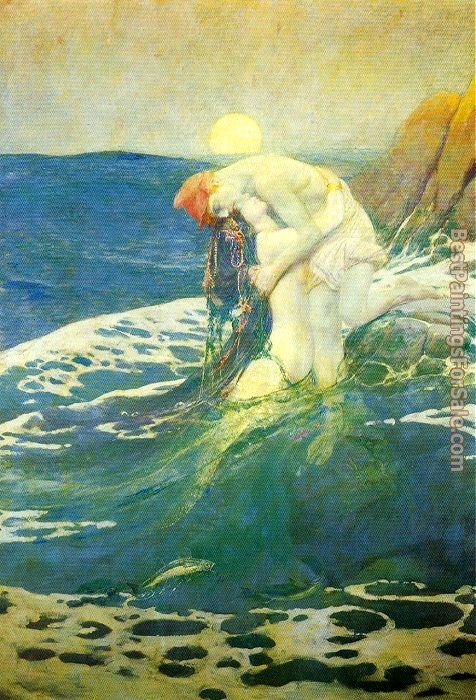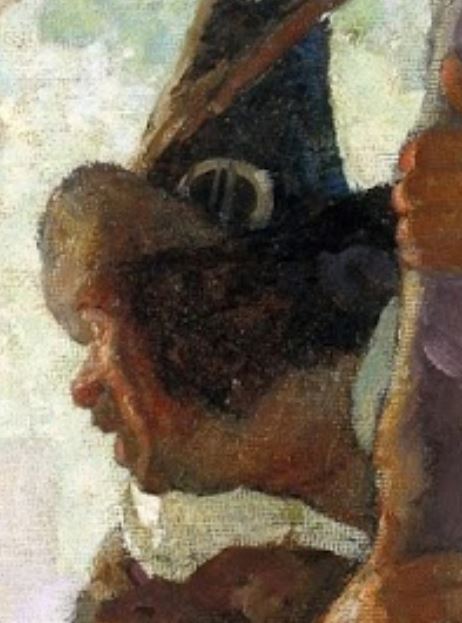Home › Forums › Explore Subjects › Illustration › Best process to paint very small faces?
- This topic has 8 replies, 5 voices, and was last updated 6 years, 10 months ago by
 JamieWG.
JamieWG.
-
AuthorPosts
-
May 25, 2017 at 6:39 pm #995118
I have been trying to figure out how N.C. Wyeth managed to paint such incredibly realistic faces. I can see the canvas threads on a lot of his paintings, so the faces can’t be more than about ½ to ¾ inch. Does any one know if that is true?
Well small brushes could possibly do it, but I was thinking that maybe he used ink pens for a lot of it. I was also thinking about trying that Fredrix Watercolor Canvas. Water colors can be erased from it.
This is one by Howard Pyle….did they actually paint on canvas?
 May 29, 2017 at 12:08 pm #1269836
May 29, 2017 at 12:08 pm #1269836That is something that eludes me as well. I forcefully need to do images small enough that the detail on the faces do not matter or big enough that the face has at least 6-7 cm to make it recognizable. I really wanted to know how some artists can make a face recognizable with just a couple centimeters to work on. I know I know practice.. but for god’s sake… from all things this is among the hardest I have ever faced ( no pun intended) .
"no no! You are doing it all wrong, in the internet we are supposed to be stubborn, inflexible and arrogant. One cannot simply be suddenly reasonable and reflexive in the internet, that breaks years of internet tradition as a medium of anger, arrogance, bigotry and self entitlement. Damm these internet newcomers being nice to to others!!!"
"If brute force does not solve your problem, then you are not using enough!"
May 30, 2017 at 2:48 pm #1269839N.C. Wyeth was a real master. Here is one showing the threads and the paint.
It is a close up of a larger painting.
May 30, 2017 at 3:03 pm #1269834The simple solution is to paint on a much larger scale than what you are accustomed to. When you paint on a large scale then what was small on your standard scale becomes workable on the larger.

http://www.flickr.com/photos/pa-paw/
[FONT=Calibri]Photography and Art WorkJune 3, 2017 at 4:18 pm #1269840I’m actually thinking about doing that, then cut out the face and reduce it with Gimp to paste it into the 16×20 size I do for storage. I don’t have room for bigger canvases.
But then I will have to learn to use Gimp, and I am just terrible with learning from words or even the videos on the youtube.
I gotta book about NC Wyeth, he was a student of Howard Pyle’s. And there was a photo of him standing next to some of his images. They are larger than I expected, up to his belt.
The simple solution is to paint on a much larger scale than what you are accustomed to. When you paint on a large scale then what was small on your standard scale becomes workable on the larger.
 June 3, 2017 at 5:59 pm #1269835
June 3, 2017 at 5:59 pm #1269835More information needed. A 16” x 20” is a decent sized canvas, but what is the diameter of the small faces that you want to paint? If the face in question is say 1” in diameter then it should be doable. Something that small in relation to the overall illustration will not need perfect detail. The idea is to convey the impression of a face and let the viewer mentally fill in the blanks.:)
http://www.flickr.com/photos/pa-paw/
[FONT=Calibri]Photography and Art WorkJune 6, 2017 at 12:02 pm #1269838what strikes me when viewing many images that are small but seem very “realistic” is that when you look close the images are generally not as detailed as you think, and very rarely line based. Some color and shading to suggest shape and some very well placed lines and the brain of the viewer does the rest to suggest the detail that the artist left out, especially at typical viewing distances.
June 6, 2017 at 3:17 pm #1269841ya I forgot that all illustations will be reduced….I usulaly think of them as wall art. or easel paintings as some one called it in a book about NC Wyeth…..
More information needed. A 16” x 20” is a decent sized canvas, but what is the diameter of the small faces that you want to paint? If the face in question is say 1” in diameter then it should be doable. Something that small in relation to the overall illustration will not need perfect detail. The idea is to convey the impression of a face and let the viewer mentally fill in the blanks.:)
June 7, 2017 at 9:50 am #1269837Here area unit some steps to form a good illustrated direction.
=>Engage Your Senses
=>Identify the task of Your Illustrated direction
=>Select a direction
=>Build Your construct
=>Set Up Your File
=>Layout Your Page
=>Choose your Fonts
=>Create & Illustrate
=>Evaluate Your Illustrated direction
=>Post and Share your direction -
AuthorPosts
- The topic ‘Best process to paint very small faces?’ is closed to new replies.
Register For This Site
A password will be e-mailed to you.
Search
